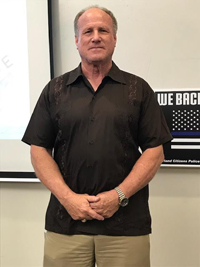Week 4 of the Citizens Police Academy included an education about the Criminal Investigations Division as well as the Major Cases/Critical Incidents Division.
Captain Mark Riggs, from Criminal Investigations, has been a law enforcement officer for 44 years, and in his job, he handles crimes against people and crimes against property. He explained the procedure from the time a crime is reported.
First, a report is made by patrol officer. If further investigation is required, CID reviews and assigns the case as appropriate. The leads are then investigated.
The outcome of the steps above can vary. An arrest can be made. Exceptional clearance can be given, which means that for one of several reasons, the case is cleared with no further investigation. Some of those reasons include that the person committed crimes here and another location and the case was sent to the other location; the incident was found to be self-defense; the case was unfounded or not true; the offense did not actually occur; leads were exhausted; or there were no active leads. Exceptional clearance is also the outcome when the complainant refuses to cooperate or the offender dies.
In the event that an arrest is made, the case is presented to the district attorney’s office and possibly referred to a grand jury. The grand jury then decides whether or not to pursue. The case can be no-billed if the grand jury does not feel there is sufficient evidence or it can be true billed if they find sufficient evidence to proceed to trial.
The crimes against persons side of CID includes:
- Capers (murder, all assaults, including sexual assault, domestic violence, harassment, robberies)
- Youth crimes
- Specialized crimes
- Narcotics
- Crimes against property side of CID includes:
- Burglary/Auto theft
- Theft/Criminal mischief
- Financial crimes (forgery, fraud)
Officers must follow a specific set of procedures at crime scenes. The scene must be secured, including all perimeters (which can become complicated with multiple locations at a scene); identification of all people, along with contact info, must be collected; a check for nearby video cameras at residences, businesses or nearby intersections, as well as the officers’ body cameras must be conducted.
This doesn’t all happen in 60 minutes like on television crime shows and the answers do not present themselves wrapped in a neat little box with a bow. The process is time-consuming and difficult and a specific type of training and expertise are required.
Detective Gary Sweet, Major Cases/Critical Incidents, has been involved in approximately 200 murder cases in his current role.
“There’s a ton of stress. When I have a murder case, I sleep maybe two or three hours a night,” he said. “It has caused health problems. I’ve had heart surgery.”
Despite the stress, he has no plans to retire.
Sweet provided a recap of a past case which involved David Penton, a serial child-killer, who abducted, assaulted and murdered an undetermined number of young girls in the 1980s.
In the DFW area, Penton abducted Christi Meeks from Mesquite, Christi Proctor from Dallas and Roxanne Reyes from Garland. Roxanne lived in an apartment complex near West Walnut and Jupiter Road.
Penton approached Roxanne and a playmate at the same time. The playmate was able to get away and provided a description.
In 1988, Nydra Ross was abducted and killed in Columbus, Ohio. A friend of her uncle, David Penton, was convicted of the murder. He had already been convicted of killing his own son.
Roxanne’s grandparents lived in Ohio when Penton was convicted and notified police because the man looked like the one that Roxanne’s playmate had described three years earlier. This young girl had been so accurate in her description that the grandparents recognized him in a news photo.
“The best witnesses are females,” Sweet said. “They can spot things that men don’t spot.”
Columbus officials contacted Garland and Mesquite PDs, but they were unable to prove that Penton was in this area and the three girls’ deaths became cold cases.
Because of what Sweet called “divine intervention,” after getting into Capers in 1995, a succession of events led him to become almost obsessed with the cold case. One of those events was that he received a call from a detective in another city who had received a letter from an inmate about Roxanne’s case.
It didn’t happen quickly or easily, but after many starts and stops, the puzzle pieces began to fall into place as other of Penton’s cellmates and fellow inmates came forward with information.
Sweet said that going to the Ohio prison to tell Penton that they had evidence to convict him for the Texas murders was the “highlight of his career.”
Penton knew that Texas was a death penalty state and had no desire to face murder charges here. He was so scared during the interview that he got tripped up and confessed. He also urinated in his pants.
Sweet told him, “We know you did it, we just wanted to meet you before we take you back to Texas to kill you.”
Sweet’s and the other detectives’ hard work later netted a conviction for the three local murders. Penton is suspected of killing additional girls.
Author Steve Jackson has written a book about this case that features Sweet. “Bogeyman: He Was Every Parent’s Nightmare” is available here.


